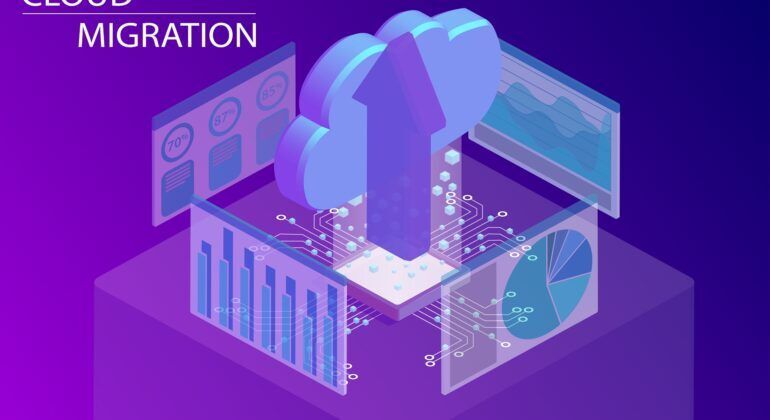Four Key Facets of Cloud Migration

There persists considerable confusion around the complete Cloud migration process. It is considered complex and beset with pit holes that can consume your business. Some consider it to be an ordeal of enormous proportions. That is probably one of the reasons why business owners are wary and skeptical about it. Today, we aim to remove all the mystery surrounding Cloud migration, break down your concerns into simple Q and As and highlight the usefulness of the Cloud by talking about the four facets of Cloud migration.
Why Is Cloud The Only Answer?
Before the COVID-19 pandemic spread like wildfire and took the world unawares, businesses moved to the Cloud, although at a slower pace. Their aim was:
- To gain flexibility and scalability in the use of data,
- Make the processes more agile,
- Improve the performance of applications,
- Cut down on unnecessary IT costs,
- Use BI (Business Intelligence) and analytics in real-time,
- Drive focus on the primary business goals.
The Cloud fulfills all these requirements and more. The icing on the cake was the realization that enterprises on the Cloud could run their business from anywhere with proper authorization for the employees. So, when COVID spread its ugly tentacles, it was relatively easy for those already on the Cloud to quickly regain their feet.
In the present times, every business owner wishes to achieve the same set of objectives. In short, their purpose is the same:
- Cut down costs.
- Reduce wastage
- Improve application performance.
- Concentrate on just running the business.
All this is possible only through Cloud migration. Maintaining the Cloud and its offerings is the headache of the Cloud Service Provider. The companies just pay a fee to use them. At present, there is no other platform that meets all the known and unknown demands of every type of business. Therefore, as of today, the only answer is the Cloud.
What To Migrate To The Cloud?
The main reason behind Cloud migration is to simplify the in-house or on-premise IT landscape. Earlier, due to the concerns regarding data safety on the Cloud, enterprises only shifted those apps and information which they thought to be non-critical to free up space. They stored them on the company servers, the management, and maintenance of which was expensive. Add to that their limited storage capacity, which meant purchasing more equipment when the business expands.
The years 1920 and 1921 (the pandemic years) have proved beyond doubt that the Cloud is a safe and secure environment. Work from home forced even the big companies to transfer their sensitive and critical data to the Cloud so that work could continue. As of today, no glaring repercussions of Cloud migration have come to light. More and more companies are moving all that data (sensitive and universal) necessary to maintain work continuity to the Cloud. The only change is that they are spending more on securing the best safeguards against data theft and data piracy.
Now, let’s come back to the question on hand – what to move to the Cloud? The answer is simple. All that is necessary to run your business from anywhere in the world should move to the Cloud. First, you move the critical processes and from there move down the ladder.
How To Migrate?
Cloud migration is a planned activity. It cannot happen randomly because that will disrupt the smooth working of processes and applications. As the migration starts, the benefits will seem negligible. Nevertheless, as you move along, they will only increase and remove all doubts. So here’s how you begin the process:
- First, you identify the workloads that can move as is to the Cloud. It is what you could call “lift and shift.”
- Next comes the workloads where all you need to do is make some minor changes to make them Cloud-ready.
- Some processes will need complete reengineering or rebuilding before actual migration. These are the most time-consuming and need to be perfected for the Cloud environment.
- Finally, you replace the software by purchasing the Cloud’s Software as a Service.
When Is The Right Time To Move To The Cloud?
In a word, the answer to the above question is “Now,” but that is easier said than done. For one, it’s impossible to move everything in a day and get things up and running without hiccups. Secondly, as we mentioned earlier, it can’t happen on a whim and needs accurate and in-depth planning. Startups have an easier time because they can begin from the Cloud space itself. The problem is faced by those companies who are set in their ways and working with on-premise servers. For them, changing their mindset will take time. But while working towards gathering support for Cloud migration, they can, side by side, begin identifying critical processes, applications, and data and move down to the least important ones. The amount of time this proactive step will save later is enormous.
Prior to migrating, it is essential to build its roadmap. It will clearly lay down the timelines for testing, tweaking, and actual migration of the workloads one at a time. Once everything is sorted and aligned correctly, you can start with the migration process.
Final Thoughts
Cloud is the demand of time. The future may bring in more scenarios, like the current pandemic situation, and necessitate work from anywhere in the world. That is the time when you will be thankful for the timely action.
Cloud migration is not something to be scared or overwhelmed about. It sounds complicated, but thanks to the support system provided by the Cloud Service Providers and Cloud Computing Companies , you can now seek help from the very beginning. They will guide you through the complete process and smoothen the way. With their help, you can overcome all challenges and free your enterprise from the burden of maintaining and managing a cost-heavy IT infrastructure and its landscape.
If you are looking for a trustworthy and reputable cloud computing partner, your search ends with Oamii Technologies . We are what you need to make the complete cloud migration process hassle-free. To book an appointment, call us at (561) 228 – 4111.
Disclaimer: The information on this website and blog is for general informational purposes only and is not professional advice. We make no guarantees of accuracy or completeness. We disclaim all liability for errors, omissions, or reliance on this content. Always consult a qualified professional for specific guidance.






